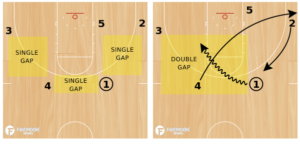12.14.22The Double Gap: How Luke Gromer Uses Video to Develop Young Athletes

A few weeks ago Luke Gromer of Cutting Edge Coaching and I ran an online workshop for coaches on the topic of using video to develop athletes.
The rationale for the session was that video is a powerful tool for building tactical and technical understanding and–through shared discussion–mutual understanding of principles across a group of athletes.
The proliferation of video and improvements in its quality and functionality recently represents a significant change in the landscape of elite athlete development. Video has become exponentially cheaper and simpler to use and therefore exponentially more common.
Result: the contemporary athlete spends an immense amount of time studying video, and the ability to learn from that video is a key driver of success for both team and individual.
However, the degree to which athletes succeed in learning from video has not necessarily increased at pace with technological advances. In fact, the rate of learning has little to do with the sophistication of the video on offer, and one could argue that the more sophisticated the technology, the more teams are likely to be distracted from the core interactions that cause people to learn: what happens to the mind of the viewer in the room where he or she is watching.
The process of shaping what happens in the minds of athletes when they watch–teaching, this is to say–is likely to determine athletes’ rate of development more than the attributes and quality of the video itself. So our focus was on how teach using video.
Here’s a great video of Luke in action with one of his teams that exemplifies several key idea we think are important.
First notice that Luke shows the video three times to his players! Video is information-dense and easily overloads working memory. Especially when you are first watching it and just trying to orient yourself to the basics of what’s happening. Luke realizes he’s seen the video five or six times and knows it frontwards and backwards but his athletes are brand new to it. He has the patience to let them watch it through one before he teaches from it.
He’s also chosen his “pause points” really carefully. He doesn’t ask them to make sense of the whole video all at once but breaks it up into small pieces. What they are looking at when they answer questions is critical because it is developing their perceptive abilities. Luke’s planned that in advance. What will I ask? When? What will my athletes look at while they try to answer?
Notice also who’s doing the cognitive work. So often the study of video for athletes involves a coach at the front of the room doing play-by-play… “Ok, guys. See this? See this? See this and this and this? The answer is, No, coach, they don’t. And if they see it they will soon forget it unless they do some thinking about it. So Luke designs his session to make players work hard cognitively!
And notice how strong his culture of error is: The content is new he reminds them. They’re not expected to get it all right away. If they struggle, ok, no problem. We’ll just work hard and build our understanding step by step.
Maybe a final thought: Notice how attentive to vocabulary Luke is. The terms he uses to describe how they play–gaps, the kinds of cuts, the names for the positions–those things are critical as they will allow them to talk about those concepts as a team during practice and games. His consistency in using precise terms (and asking his players to also) accelerates the degree to which they can transfer what they learn from the video to future on-the-court settings.
Fantastic stuff from Luke!
